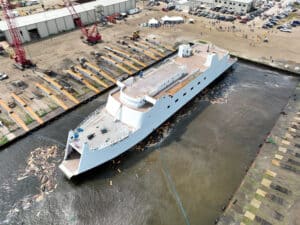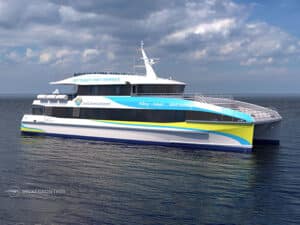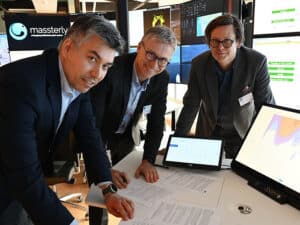
More details on Norway’s giant hydrogen fueled-ferries emerge
Written by Nick Blenkey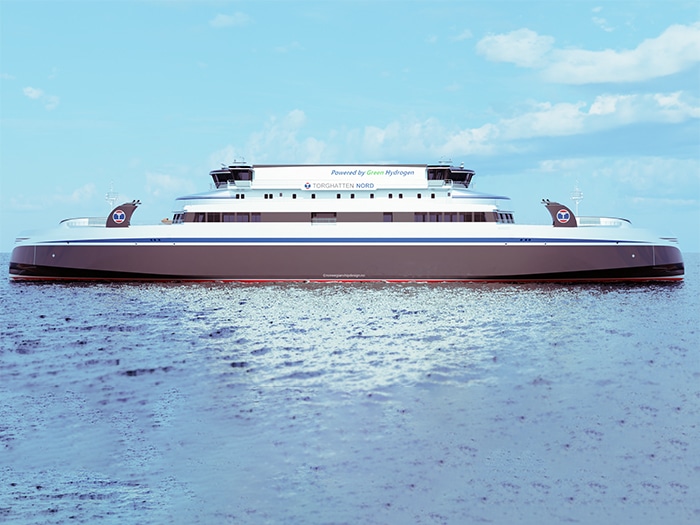
Image: The Norwegian Ship Design Company
When Norwegian ferry operator Trollhatten Nord announced that it had placed an order at the Mykelbust shipyard for what will be the world’s two largest hydrogen fueled ferries, few details of the technology that they incorporated were revealed. Now more information is starting to emerge.
First, a bit on the background to the project. The two 117-meter long ferries have been designed by the Norwegian Ship Design Company AS in a process that started in 2019 as the “hydrogen ferry to Vestfjorden” project in preparation for a tender that was subsequently announced in 2021. In 2022, Torghatten Nord signed a contract with the Norwegian Public Roads Administration to operate on Norway’s longest state ferry connection, Highway 80 across Vestfjorden and connecting Bodø, Røst, Værøy and Moskenes.. Since then an extensive development process has been underway, with the vessels receiving Approval in Principle (AiP) from Lloyd’s Register in August 2022, following the completion of a comprehensive and constructive risk-based HAZID certification.
Each of the ferries will have a capacity of 120 cars and 599 passengers. Bodø is located just north of the Arctic Circle and, as the ferries will operate on one of the longest and most challenging ferry routes in Norway, they are designed with closed car decks and a special hull design for operation in exposed waters.
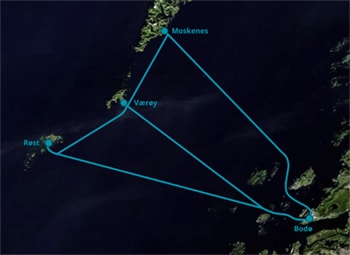
“It is essential for us to emphasize that the design and technical solutions used meet all safety aspects for ferries navigating in highly exposed waters,” says the Norwegian Ship Design company, noting that the ferries will be the world’s largest hydrogen-powered vessels and will feature the largest hydrogen installation ever installed on a ship. Each vessel will have 6,400 kW of fuel cells with associated auxiliary systems. The onboard hydrogen is stored in compressed form.
The ferries are designed for 100% zero-emissions and feature a multi-hybrid propulsion system with hydrogen-electric as the primary mode and diesel-electric, operating on bio-fuel, as the secondary mode.
“Extensive safety analyses have been conducted for the onboard hydrogen system to ensure that the ferries are as safe as modern diesel ferries,” said Norwegian Ship Design CEO Gjermund Johannessen, when the shipbuilding contract was announced. “Extensive model tests of the new hull design have also been conducted to ensure low energy consumption and good roll damping in the rough sea area that is the outer Vestfjorden. Through close collaboration with Torghatten Nord and their technical team, the project is now more than ready to welcome the respected shipyard, Myklebust Verft, on board!”
“Norwegian Ship Design delivers an extensive design package, including everything from design to 3D modeling and delivery of construction working drawings,” says Stian Holsen, Norwegian Ship Design project manager. “We look forward to an exciting and groundbreaking project, as well as a good collaboration with Torghatten Nord, Myklebust Verft, and all involved suppliers.”
Karmøy, Norway, headquartered SEAM AS has been selected as the system integrator for the project and will supply the vessels with its in-house developed control and safety system, as well as the entire powertrain, from the fuel cells in combination with batteries and switchboards, through to the electric motors for propellers.
The fuel cells will be supplied by Sweden’s PowerCell AB, under a letter of intent signed with SEAM in early February this year. PowerCell says that, with a value of EUR 19.2 million, this is the world’s largest marine industry hydrogen fuel cell project to date. It will deliver its PowerCellution Marine System 200, with a total power output of around 6 MW for each ferry. The fuel cell system is durable, has a high power-to-weight ratio, and is one of the world’s largest for marine use.
BRUNVOLL PROPULSION, MANEUVERING AND AUTONOMY
Brunvoll has been selected to deliver the propulsion, maneuvering and autonomy systems for the two hydrogen-fueled ferries.
“We are excited to take part in Myklebust Yard and Torghatten Nord’s journeys towards hydrogen powered vessels. The harsh weather conditions outside Lofoten will allow us to demonstrate the robustness of our BruCon Auto-Crossing autonomy system for ferries and we are looking forward to the delivery and commissioning for Myklebust Yard,” says Kåre Øyvind Vassdal, CEO at Brunvoll.
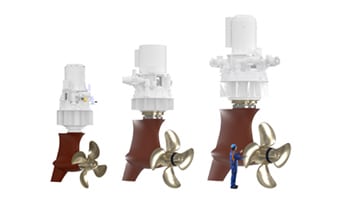
The Brunvoll contract includes two azimuth propulsion thrusters, BruCon Propulsion & Thruster Control System, BruCon Auto-Crossing system, and BruCon Condition Monitoring System. The pulling azimuth propulsion thrusters are of the largest size that Brunvoll currently delivers today, with the installation of high propulsion power is one of the design considerations which make the vessels ready for the rough sea conditions experienced in their area of operation, which is open towards the North Sea.
The BruCon Condition Monitoring System will allow for remote monitoring and operational optimization throughout the lifetime of the hydrogen-fueled ferries. To simplify the vessels day-to-day operation the BruCon Auto-Crossing system will be installed to ensure energy efficient crossing of the Ytre Vestfjord (the Outer Western Fjord) on each transit, irrespective of onboard crew, weather conditions, and other disturbances the bridge crew will have to manage.

